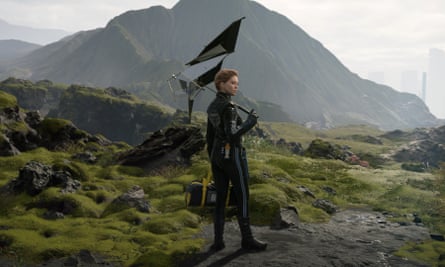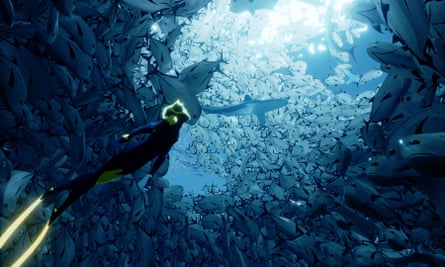
Can video games change people’s minds about the climate crisis? | Games
“It was scary. It made you realise how, despite all the sophistication of modern society, we’re still reliant on water falling from the sky.” Sam Alfred, the lead designer at Cape Town-based video game studio Free Lives, vividly remembers his city nearly running out of water. During 2018, the area surrounding South Africa’s second largest city suffered months of dwindling rainfall. Dams were unable to replenish themselves at the rate its inhabitants required. Water was rationed. Businesses shut. The situation even called for its own grim version of the Doomsday Clock: hour by hour, the city ticked ever closer to Day Zero, marking the end of its fresh water supply.
Terra Nil, the video game that Alfred has been developing since 2019, is a response to these terrifying events. Dubbed a “city-builder in reverse”, it foregoes the consumption and expansion of genre classics such as Civilisation and SimCity to paint a picture of environmental restoration. Starting with arid desert, it’s up to the player to rewild a landscape using various technologies – a toxin scrubber, for example, or a beehive. At light-speed, and with eye-massaging flushes of emerald green and azure blue, the environment transforms into lush vegetation. Terra Nil’s simplicity is as beautiful as its visuals, offering the satisfaction of a colouring book while doling out a clear-eyed critique of environment-wrecking extraction.
With Terra Nil’s story of “climate positivity”, Alfred is part of a burgeoning wave of game makers attempting to both educate players on the dangers of the climate crisis while stretching perceptions of what is possible in response to it. Niantic, the maker of Pokémon GO, has used the real-world setting of its augmented reality game to spearhead a tree-planting initiative. Ubisoft, meanwhile, staged an in-game climate march for Riders Republic players, and is set to unleash a virtual forest fire to demonstrate the devastating real-world effects of such arboreal disasters. The idea with each of these ventures is to use video games as tools of moral instruction.

For the past three years, a United Nations project called Playing for the Planet has catalysed these efforts with its annual Green Game Jam. Deborah Mensah-Bonsu, founder of partner organisation Games for Good and organiser of the jams, believes video games are perfectly placed to encourage changes in mindset and behaviour. “The idea of player agency is a really big piece [of the picture],” she says. “Within other mediums, it’s more of a passive experience. With games, you get to be part of a story – you have a say in its outcome.” She sees two sides to what the organisation is calling “green content.” On the one hand, “It’s trying to help players understand these different subjects.” On the other hand, it’s giving them “agency to take action.”
In the hidden object game June’s Journey and arcade fighter Brawlhalla, these actions amount to purchasing in-game items whose proceeds are then donated to environmental charities such as Ecologi. For deeper engagements with the brief, you have to look at titles such as snowsports utopia Riders Republic or another Ubisoft title, Anno 1800, the kind of grand city-builder that Terra Nil riffs on. Anno 1800’s ecological twist is an environment that reacts to the player’s expansionist actions. Creating monocultures depletes soil fertility, while overfishing destroys marine populations; each demand on the environment carries a consequence that could decide a city’s fate.
David Attenborough’s wonder for the natural world permeates the Horizon series, each immaculately rendered blade of grass or clump of moss a tiny act of veneration. And dark climate dread looms in the primordial landscapes of Death Stranding. However, there’s a dark contradiction at the heart of these blockbuster games: the very extraction that Terra Nil rallies against sustains players’ and the industry’s thirst for increasingly high-fidelity graphics. Every cutting-edge console, graphics card, and processor is the product of many carbon-intensive processes, including the mining of rare earth minerals.
When Sony pledges to plant trees for every “Reached the Daunt” trophy earned by players of Horizon: Forbidden West, an effort promoted as part of the 2022 Green Game Jam, it raises the spectre of greenwashing. Sony recently announced that it was accelerating its net zero commitments by 10 years, but 2020 emissions stemming from the use of its TVs and game consoles were the highest they’ve been since 2016, according to its 2021 sustainability report. Furthermore, an eye-watering 17.1m tons of C02 were created over the course of its products’ life-cycles, with a further 1.4m tons emitted from the company’s business sites. Next to these numbers, it’s hard to see tree-planting as anything other than trivial.

Radical ideas are needed if the games industry is to collectively decarbonise, and Playing for the Planet hopes to advise companies on how to do just that in the coming years. Kara Stone, a designer and assistant professor at Alberta University of the Arts, is already working on a quietly radical alternative from her south-facing apartment balcony in Calgary: a solar-powered web server that players will be able to stream her games from. The first is called Known Mysteries, a deduction game set in a near-future Canada held captive by massive oil companies. Stone says it’s partly inspired by her home of Calgary, a city she describes as the “oil capital of Canada”.
It will feature “recycled” visuals sourced mostly from 1970s industrial and nature films; Stone is compressing the images so that the game can fit on the tiny solar-powered web server she’s making using a panel bought off Craigslist, a Raspberry Pi microcomputer, and an old car battery. Stone’s work gently challenges the idea that increasingly high-resolution graphics, whose rendering requires ever-larger amounts of electricity, is the indisputable future for games. And because it runs on a solar server in the often dark and cloudy climate of Canada, players may be unable to access her game 24/7. “Not everything has to be accessible to everybody at every single moment,” Stone says. “I’m not really too concerned if it goes down for even a few hours a day every day … Full access to every user is such a capitalist mindset.”
Stone isn’t trying to convince an audience of anything, she says; “that’s a condescending place to come from.” Jonathan Hau-Yoon, art lead on Terra Nil, is similarly uninterested in changing people’s minds, preferring to show players an alternative to the status quo and let them do the rest. He references the futurist Monika Bielskyte, who thinks about “protopian” rather than utopian futures – a world of plural futures, rather than just one. “It’s very much the idea of creating positive things to inspire imaginations,” Hau-Yoon says. “To think in terms of possibilities.”
The question is whether any of this can move the needle on players’ attitudes towards the climate crisis. According to new data collected through a number of mobile titles by Mensah-Bonsu and Playing for the Planet, the answer tentatively suggests it can. Of 389,594 respondents (split evenly across men and women with the greatest number between the ages of 21 to 39), 78.6% believe that gaming could help them learn about the environment and 35.4% want to see more environmental content in their games. Nearly two-thirds of respondents (61.1%) said they would be motivated to pay for environmentalist content if it added to their in-game experience, supported a good cause, or taught them something new.

Mensah-Bonsu stresses the research is far from “the final word on the subject”. She says further studies with greater academic rigour are required, but it’s the first step in validating work that, until now, was unproven. At the very least, Mensah-Bonsu says, the research shows that engaging with the climate crisis isn’t a turn-off for players. Establishing causation would be harder: many have tried to find a link between games and player behaviour when it comes to video games and violence, at great length and even greater cost, and none have succeeded.
Regardless of whether it changes minds or behaviour, there’s an appetite from game makers and players alike to engage with the ongoing threat of global heating. Games such as ABZÛ and Alba: A Wildlife Adventure – ecological fables set in the ocean and on land – are among many that show us a way of seeing the world that isn’t through an aiming reticle.






